History dies deep in the woods: The forgotten Nazi concentration camp survivors in the forests of Småland

History writer Victoria Martínez investigates an almost forgotten part of Sweden's past, the story of the 1,000 Polish survivors of Nazi concentration camps who ended up in a refugee camp deep in the woods of Småland county.
History has a way of being forgotten, whether by accident or design, especially when it’s painful. Histories with straightforward and happy endings make us feel good about ourselves and more hopeful about the outcome of our own uncertain times. Those that lack resolution or defy the need for an optimistic conclusion frequently exist in varying degrees of figurative darkness – ignored, neglected, forsaken. Sometimes, the darkness is also literal – a place so tucked away from view that the eyes of the collective consciousness barely need to look away to forget.
Just such a place exists in Öreryd, Sweden, where a World War II refugee camp once stood. There, deep in the forests of Småland, the painful yet vitally-important history of 1,000 survivors of Nazi concentration camps has been left to die in the woods.
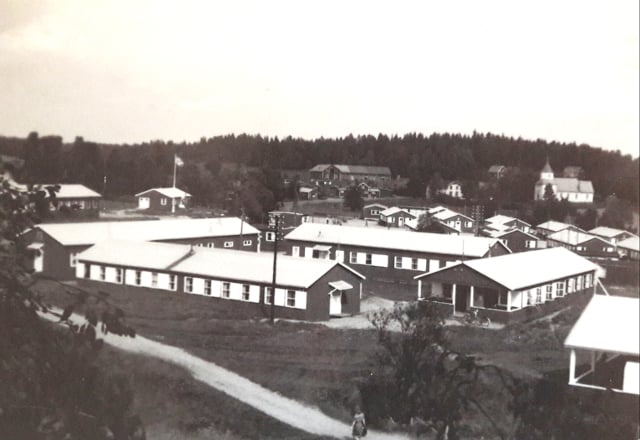
The Öreryd refugee camp. Photo: Öreryds Hembygdsförening
In and out of memory
On May 8th 1945, the previous occupants of the Öreryd refugee camp – the last of some 40,000 Norwegians who had transited through the small village since 1941 – celebrated VE Day by marching off to the train station in nearby Hestra with much fanfare. They were returning to their homeland, only just liberated from Nazi occupation. They left behind an almost uniformly pleasant legacy that is noted in local tourist information.
The mainly Polish survivors of Nazi concentration camps who began to stream into Öreryd just weeks later in June 1945 are not mentioned alongside the Norwegians in the tourist material; not even the two buried in the cemetery behind the 18th century church. There was no celebratory parade to see off the last of them before the camp closed for good in autumn 1946. Their legacy is – like their time there had been – more complex and painful than that of the Norwegians. It is also a legacy that is far more fragmented, obscure, and poorly documented.
In the collective consciousness of Sweden and the rest of the world, the history of these Polish refugees usually begins and ends with their safe arrival to Sweden in the spring and summer of 1945. That story is better-known, not least because it involved the largest rescue operation to take place within Nazi Germany during World War II: the Swedish Red Cross’s “White Buses” operation, which had been negotiated between the organization’s vice-president, Count Folke Bernadotte – a member of Sweden’s royal family – and Nazi Reich leader Heinrich Himmler.
Conducted in March and April 1945, this heroic operation involved multiple round-trip journeys within Nazi Germany between two active front lines and into working concentration camps, from which some 21,000 prisoners of many nationalities were liberated and brought to safety in Sweden. That summer, a further 10,000 survivors were given refuge in Sweden at the request of the United Nations Refugee and Rehabilitation Administration (UNRRA).
Of the 31,000 people liberated through these efforts, approximately 40 percent were Polish and one-third or more were Jewish. According to Lars Olsson, Professor Emeritus in History at Linnaeus University, 43 percent of the approximately 10,000 Jewish survivors were Polish. The roughly 1,000 Jewish and non-Jewish Poles who made their way to the Öreryd refugee camp in 1945 were part of this group of survivors.
All came to Sweden broken to some degree, physically and psychologically. Swedish media reports on the arrival of the survivors to Malmö were filled with descriptions of their shocking appearance. Skeletal, filthy, tattooed with serial numbers, dressed in rags and prison clothes marked with various designations. In short, they had been “degraded to animals,” as a journalist wrote in Expressen in June 1945. Around 90 percent of the UNRRA refugees had tuberculosis. All were quarantined for at least two weeks, and many were hospitalized for extended periods. Quite a few didn’t long survive their rescue, as evidenced by cemeteries like Norra kyrkogården in Lund.
Although most of the survivors didn’t die in places like Malmö and Lund, their stories become obscure and frequently disappear after their departure for one of the 150 refugee camps located mainly in southern Sweden, including Öreryd. Then, as now, this lapse is a disservice not only to the survivors, but also to Swedish society and posterity. As prominent Swedish journalist Göran Rosenberg wrote about Holocaust survivors such as his father: “It’s impossible to think you’ve all survived in order for the world to forget what it’s just been through and to go on as if nothing has happened.”
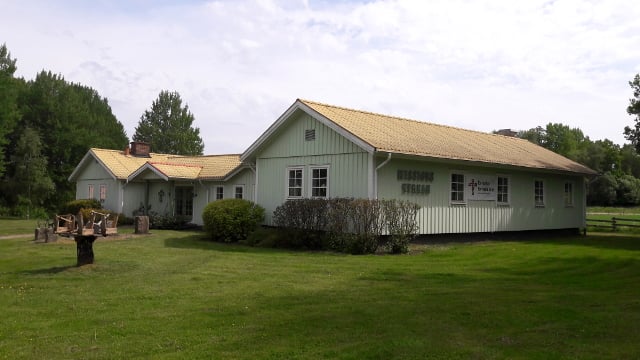
Two of the barracks from the refugee camp were reused for the Öreryd Missionskyrkan building. They are two side wings of the building that are united by a modern structure in the middle. Photo: Victoria Martínez
The Curtain of Silence
The story of David Rosenberg – a Jewish survivor of the Łódź ghetto, Braunschweig slave labour camp, and Auschwitz-Birkenau and Ravensbrück concentration camps – as told in A Brief Stop on the Road from Auschwitz, is undoubtedly the most high-profile account of a Polish concentration camp survivor who was at the Öreryd refugee camp. Originally published in Swedish in 2012 as Ett kort uppehåll på vägen från Auschwitz, Göran Rosenberg’s book has since been translated into ten languages. In addition to grappling with what he calls the “curtain of silence… between the world the visitors bring with them and the world that surrounds them”, both then and now, Rosenberg provides personal insight into the issues and challenges the concentration camp survivors faced in Öreryd.
Like David Rosenberg, who had arrived in Malmö ill with typhus and weighing only 36 kilos, the Polish refugees who came to Öreryd freshly released from quarantine or hospital were nonetheless nowhere near “recovered” from their ordeals. On the contrary, they were just beginning a physical, emotional and psychological journey away from the atrocities inflicted on them, their families, and their homeland. In this sense, the title of Rosenberg’s book is particularly apt. Öreryd, like all Swedish refugee camps, was a brief stop on the refugees’ journeys from Nazi concentration camps to a new life they had to somehow piece together.
Arriving at this stop, they would have found that the camp was a well-oiled machine after four years in service. Built beginning in May 1940, almost immediately following the German invasions of Denmark and Norway, it was originally intended as a work camp for ambiguously-described “icke behagliga personer,” which translates approximately to “uncomfortable people”. For neutral Sweden, awkwardly located between Nazi Germany and Communist Russia and their respective occupied territories, this broad terminology allowed for the internment of anyone who could not be trusted by Swedish authorities in the event the country became directly involved in the war.
It was never used for this original purpose, and it remained empty until March 1941 when it began receiving Norwegians fleeing their country’s Nazi occupation, most of whom stayed only for short periods. During 1944 and 1945, it also served as a military camp for the training of Norwegian reserve police, which was effectively part of the Norwegian resistance.
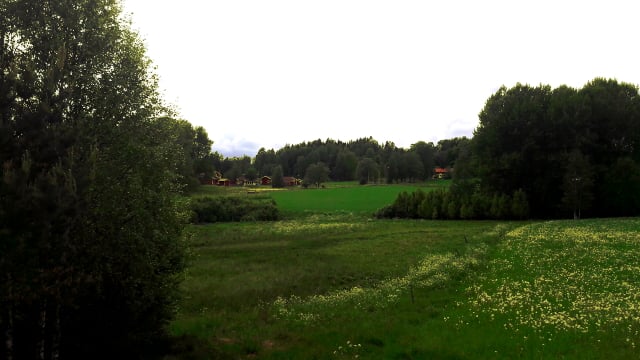
A recent photo of part of the site where the refugee camp once existed, taken from Highway 26. Photo: Victoria Martínez
The location of the camp was strategic. With a population of 316 in 1940, Öreryd was located out of the way in the dense forests of Småland, where tight controls and secrecy could be maintained. Just 55 kilometres south-west of Jönköping, with access to the Nissastigen road (now a part of Highway 26) that links Jönköping and Halmstad, and the train station in Hestra – a stop on the Borås-Alvesta Railway line – the location also offered good communication with and transportation to other parts of Sweden.
Although the camp and the locals were the same as when the Norwegians were there, the experiences of the Polish refugees were entirely different. Whereas similar culture and language had meant the Norwegians and Swedes were able to socialize and communicate easily, the Polish refugees and the Öreryd locals faced major cultural and communication barriers. More crucially, the gravity of the Polish refugees’ experiences would have been almost unfathomable to everyone, making reaching out to seek or provide help much more difficult. These factors, along with sparse historical records, have undoubtedly played a role in keeping the Polish refugees’ stories so fragmented and obscure. A key example is the story of the two graves in the Öreryd church cemetery that have been a virtual mystery since the internments in 1945 and 1946.
In spring 1972, the late Swedish journalist and author Jan Olof Olsson – known as Jolo – happened upon the graves, marked only with the names Mgr Antoni Wierzbowski and Ignacy Hundzel. He wrote about his discovery in Dagens Nyheter in April, pondering how two Polish Catholics came to be buried in a tiny Swedish Protestant cemetery. A short response from former Öreryd church officials was published six days later. It was probably the first time in decades that a mention of Polish concentration camp survivors in Öreryd appeared in print. This brief public exchange shed a bit of light on the subject, but mainly highlighted how little was known about the Polish refugees, even by people who had been in Öreryd at the time.
All parties to this exchange agreed that the “Mgr” designation meant that Antoni Wierzbowski had been a Catholic monsignor. In fact, it is an abbreviation of the Polish academic degree of Magister, which is equivalent to a Master’s degree. As a Pole with a high level of education, Magister Wierzbowski had probably been a target of the Nazi’s systematic elimination of Polish intellectuals and elites that began in 1939. In two genocidal operations, the Intelligenzaktion in 1939 and the AB-Aktion in 1940, approximately 68,000 members of Poland’s intelligentsia were executed by the Nazis, and many more were imprisoned in concentration camps. As a survivor, Magister Wierzbowski would have been justifiably proud of his academic title, as would his fellow Poles who buried him in the Öreryd church cemetery on March 21st 1946, following his death by a probable heart attack.
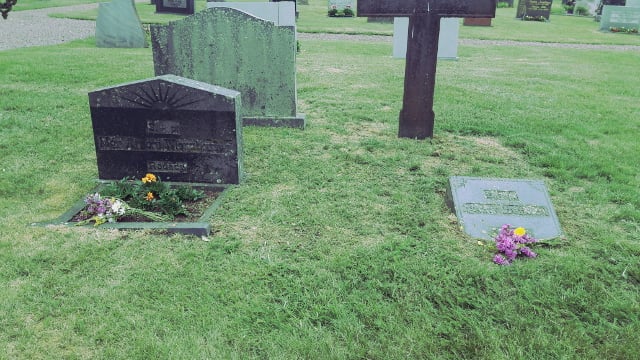
The graves of Magister Antoni Wierzbowski (1907-1946) and Ignacy Hundzel (1911-1945). Locals say a relative of Magister Wierzbowski has been to the grave and that flowers are sometimes left or planted there. The latter was the case when this photo was taken. The wildflower bouquets were offered by the author´s children. Photo: Victoria Martínez
This 70-year-old misunderstanding of three letters with great meaning is part of the legacy of “the curtain” referred to by Göran Rosenberg. Karl Gustav Rinder, who was a minister in Öreryd until 1946, also mentioned it in his part of the response to Jolo. He wrote that although a Catholic priest from Gothenburg had initially been at the camp, “A little later, a priest came from Poland and then the curtain was pulled down… They isolated themselves completely from us and handled all the ceremonies themselves. I remember that tragic deaths occurred in the camp, but I think that they were never reported, there is probably nothing in our church books.”
Of the occupant of the second grave, Ignacy Hundzel, little is known except that his death in 1945 was apparently a suicide. Despite the presence of health professionals and mental health counselors at the refugee camp, suicides were not uncommon.
“Suicides were not a surprise. We were only surprised there weren’t more of them,” said Inga Ericsson, 82, whose parents, Gustav and Elsa Fält, were prominent citizens in Öreryd.
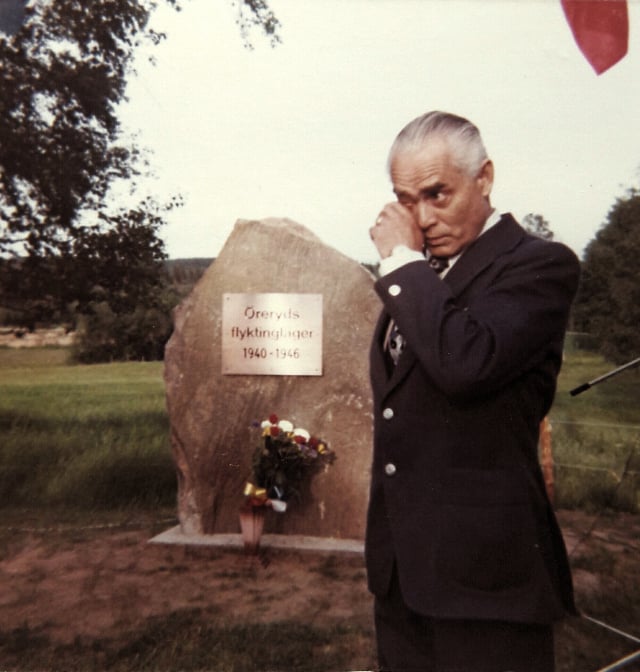
Marian Michalak, a Polish survivor of the Holocaust who was a refugee in the Öreryd camp, taken in 1977 when the monument was erected. Michalak remained in Sweden, settling in or near Gislaved. Photo: Anders Palm
The experiences and descriptions of survivors like 16-year-old Anna Krasińska, who had been in a slave labour camp in Neustrelitz, Germany, from 1940 to 1945, help make it possible for those of us detached from this terrible period of history to comprehend what Inga meant. Interviewed in 1946 during her time in Öreryd as part of an initiative by The Polish Research Institute in Lund, Anna recounted experiences at Neustrelitz like discovering fingers and ears in her soup. The interviewer’s tragic summary of Anna reads in part: “She gives [the] impression that underneath [the] guise of getting tame with people and with the present surrounding, she is stacked in tragedy of a lonely and wronged child who passed through [the] bottom of evil and [the] bottom of physical and moral misery.”
In researching the Öreryd refugee camp, there is certainly the impression that normalcy was a pretense clung to by both survivors and locals. However, for the survivors, there is also the sense that it was a byproduct of the routine activities necessary to rebuild a life. On the one hand, the desire to look ahead may have been driven by a fear of looking back at the Nazi atrocities. On the other hand, the tasks necessary for reconstruction gave the impression that the survivors were moving forward in a natural manner.
For many of the Öreryd refugees, this would have included determining if loved ones had survived and, if so, where they were and how to contact them. Inga Ericsson recalls how on her daily walk to school, she helped a Polish refugee call his wife, who was 100 kilometers away in a refugee camp in Solberga. The details of that routine – including the woman’s name and the telephone number – are etched in Inga’s memory to this day because they were, in fact, anything but routine. This type of daily quest or activity would have given the refugees a purpose and direction that could have made it appear as though the terrors of the concentration camps were dissolving neatly into the past.
In reality, the survivors were coping not only with the past, but also dealing with the challenges of daily life in the refugee camp. Jewish survivors, for instance, were often confronted with anti-Semitism from their non-Jewish countrymen within the camp. Students at the Polish gymnasium established in Öreryd completed two years of study in one year and took their exams without the benefit of books. And although some refugees found temporary work in factories, forests and fields, these situations presented challenges of their own and did not usually offer a path to a more permanent future in Sweden or anywhere else.
On 14 September 1946, the story of the Öreryd refugee camp was neatly concluded when Jönköpings-Posten reported that 13 students of the Polish high school celebrated the completion of their exams. Two of the students, including 21-year-old Auschwitz survivor Vanda Nekvasz, spoke about their futures with uncertainty. Both told the newspaper that they wanted to study or work in Sweden, but also wished they could return to Poland. Even with the sense of mildly-festive optimism that permeated the article, neither option seemed very likely to occur. And with that, the stories of the Polish refugees in Öreryd drifted into obscurity.
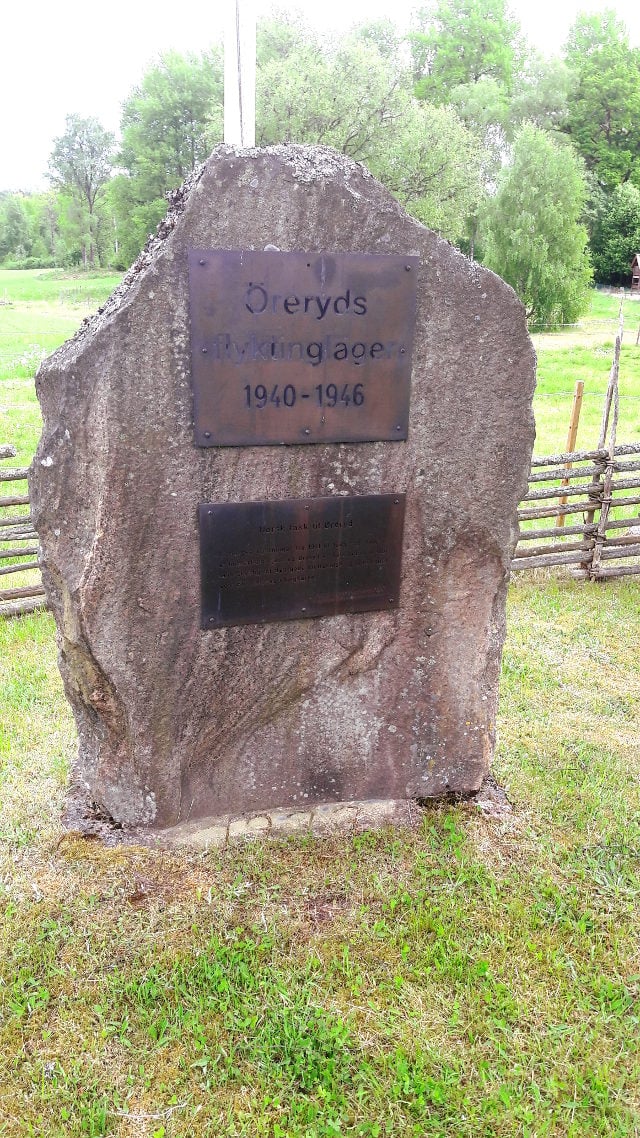
A recent photo of the monument stone. Photo: Victoria Martínez
Looking Back to See Ahead
In 1977, a stone monument was raised along Öreryd’s main road. The original plaque reads simply, “Öreryds flyktingläger 1940-1946” (Öreryd refugee camp). Another plaque, added to the stone in 1980, is a token of gratitude from the Norwegians who once found refuge there. On certain days of the year, three flags are raised behind the monument: the Swedish, the Norwegian, and the Polish. Few will see this sight and even fewer know it exists. Almost no one would know what the Polish flag signifies.
As World War II and the Holocaust pass out of living memory, the history of the survivors of Nazi concentration camps in Swedish refugee camps like Öreryd is in danger of being lost entirely, even as it has profound relevance to our own time. With the United Nations calling the ongoing conflict in Syria “the biggest humanitarian and refugee crisis of our time”, and Sweden again taking in large numbers of refugees, it’s more important than ever to look back to discover what a painful history like this can teach us about our individual and collective responses to such events.
History only dies deep in the woods if we allow it to waste away in darkness.
Victoria Martínez is an American historical researcher, writer and author of three historical non-fiction books. She lives in Småland county, Sweden, with her Spanish husband and their two children.
If you or someone you know was a survivor of Nazi concentration camps who became a refugee in Öreryd or anywhere else in Småland and would like to share the story, or if you have other information related to the camps or the refugees that you wish to share, please contact Victoria.
Many thanks to Karin Johansson and Anders Palm, who are dedicated to the history of Öreryd, Inga Ericsson, whose childhood memories of Öreryd are invaluable, and to Dr. Paul A. Levine, Gillian Eriksson-Wijk and David Martínez for their assistance and support.
Comments
See Also
History has a way of being forgotten, whether by accident or design, especially when it’s painful. Histories with straightforward and happy endings make us feel good about ourselves and more hopeful about the outcome of our own uncertain times. Those that lack resolution or defy the need for an optimistic conclusion frequently exist in varying degrees of figurative darkness – ignored, neglected, forsaken. Sometimes, the darkness is also literal – a place so tucked away from view that the eyes of the collective consciousness barely need to look away to forget.
Just such a place exists in Öreryd, Sweden, where a World War II refugee camp once stood. There, deep in the forests of Småland, the painful yet vitally-important history of 1,000 survivors of Nazi concentration camps has been left to die in the woods.

The Öreryd refugee camp. Photo: Öreryds Hembygdsförening
In and out of memory
On May 8th 1945, the previous occupants of the Öreryd refugee camp – the last of some 40,000 Norwegians who had transited through the small village since 1941 – celebrated VE Day by marching off to the train station in nearby Hestra with much fanfare. They were returning to their homeland, only just liberated from Nazi occupation. They left behind an almost uniformly pleasant legacy that is noted in local tourist information.
The mainly Polish survivors of Nazi concentration camps who began to stream into Öreryd just weeks later in June 1945 are not mentioned alongside the Norwegians in the tourist material; not even the two buried in the cemetery behind the 18th century church. There was no celebratory parade to see off the last of them before the camp closed for good in autumn 1946. Their legacy is – like their time there had been – more complex and painful than that of the Norwegians. It is also a legacy that is far more fragmented, obscure, and poorly documented.
In the collective consciousness of Sweden and the rest of the world, the history of these Polish refugees usually begins and ends with their safe arrival to Sweden in the spring and summer of 1945. That story is better-known, not least because it involved the largest rescue operation to take place within Nazi Germany during World War II: the Swedish Red Cross’s “White Buses” operation, which had been negotiated between the organization’s vice-president, Count Folke Bernadotte – a member of Sweden’s royal family – and Nazi Reich leader Heinrich Himmler.
Conducted in March and April 1945, this heroic operation involved multiple round-trip journeys within Nazi Germany between two active front lines and into working concentration camps, from which some 21,000 prisoners of many nationalities were liberated and brought to safety in Sweden. That summer, a further 10,000 survivors were given refuge in Sweden at the request of the United Nations Refugee and Rehabilitation Administration (UNRRA).
Of the 31,000 people liberated through these efforts, approximately 40 percent were Polish and one-third or more were Jewish. According to Lars Olsson, Professor Emeritus in History at Linnaeus University, 43 percent of the approximately 10,000 Jewish survivors were Polish. The roughly 1,000 Jewish and non-Jewish Poles who made their way to the Öreryd refugee camp in 1945 were part of this group of survivors.
All came to Sweden broken to some degree, physically and psychologically. Swedish media reports on the arrival of the survivors to Malmö were filled with descriptions of their shocking appearance. Skeletal, filthy, tattooed with serial numbers, dressed in rags and prison clothes marked with various designations. In short, they had been “degraded to animals,” as a journalist wrote in Expressen in June 1945. Around 90 percent of the UNRRA refugees had tuberculosis. All were quarantined for at least two weeks, and many were hospitalized for extended periods. Quite a few didn’t long survive their rescue, as evidenced by cemeteries like Norra kyrkogården in Lund.
Although most of the survivors didn’t die in places like Malmö and Lund, their stories become obscure and frequently disappear after their departure for one of the 150 refugee camps located mainly in southern Sweden, including Öreryd. Then, as now, this lapse is a disservice not only to the survivors, but also to Swedish society and posterity. As prominent Swedish journalist Göran Rosenberg wrote about Holocaust survivors such as his father: “It’s impossible to think you’ve all survived in order for the world to forget what it’s just been through and to go on as if nothing has happened.”

Two of the barracks from the refugee camp were reused for the Öreryd Missionskyrkan building. They are two side wings of the building that are united by a modern structure in the middle. Photo: Victoria Martínez
The Curtain of Silence
The story of David Rosenberg – a Jewish survivor of the Łódź ghetto, Braunschweig slave labour camp, and Auschwitz-Birkenau and Ravensbrück concentration camps – as told in A Brief Stop on the Road from Auschwitz, is undoubtedly the most high-profile account of a Polish concentration camp survivor who was at the Öreryd refugee camp. Originally published in Swedish in 2012 as Ett kort uppehåll på vägen från Auschwitz, Göran Rosenberg’s book has since been translated into ten languages. In addition to grappling with what he calls the “curtain of silence… between the world the visitors bring with them and the world that surrounds them”, both then and now, Rosenberg provides personal insight into the issues and challenges the concentration camp survivors faced in Öreryd.
Like David Rosenberg, who had arrived in Malmö ill with typhus and weighing only 36 kilos, the Polish refugees who came to Öreryd freshly released from quarantine or hospital were nonetheless nowhere near “recovered” from their ordeals. On the contrary, they were just beginning a physical, emotional and psychological journey away from the atrocities inflicted on them, their families, and their homeland. In this sense, the title of Rosenberg’s book is particularly apt. Öreryd, like all Swedish refugee camps, was a brief stop on the refugees’ journeys from Nazi concentration camps to a new life they had to somehow piece together.
Arriving at this stop, they would have found that the camp was a well-oiled machine after four years in service. Built beginning in May 1940, almost immediately following the German invasions of Denmark and Norway, it was originally intended as a work camp for ambiguously-described “icke behagliga personer,” which translates approximately to “uncomfortable people”. For neutral Sweden, awkwardly located between Nazi Germany and Communist Russia and their respective occupied territories, this broad terminology allowed for the internment of anyone who could not be trusted by Swedish authorities in the event the country became directly involved in the war.
It was never used for this original purpose, and it remained empty until March 1941 when it began receiving Norwegians fleeing their country’s Nazi occupation, most of whom stayed only for short periods. During 1944 and 1945, it also served as a military camp for the training of Norwegian reserve police, which was effectively part of the Norwegian resistance.

A recent photo of part of the site where the refugee camp once existed, taken from Highway 26. Photo: Victoria Martínez
The location of the camp was strategic. With a population of 316 in 1940, Öreryd was located out of the way in the dense forests of Småland, where tight controls and secrecy could be maintained. Just 55 kilometres south-west of Jönköping, with access to the Nissastigen road (now a part of Highway 26) that links Jönköping and Halmstad, and the train station in Hestra – a stop on the Borås-Alvesta Railway line – the location also offered good communication with and transportation to other parts of Sweden.
Although the camp and the locals were the same as when the Norwegians were there, the experiences of the Polish refugees were entirely different. Whereas similar culture and language had meant the Norwegians and Swedes were able to socialize and communicate easily, the Polish refugees and the Öreryd locals faced major cultural and communication barriers. More crucially, the gravity of the Polish refugees’ experiences would have been almost unfathomable to everyone, making reaching out to seek or provide help much more difficult. These factors, along with sparse historical records, have undoubtedly played a role in keeping the Polish refugees’ stories so fragmented and obscure. A key example is the story of the two graves in the Öreryd church cemetery that have been a virtual mystery since the internments in 1945 and 1946.
In spring 1972, the late Swedish journalist and author Jan Olof Olsson – known as Jolo – happened upon the graves, marked only with the names Mgr Antoni Wierzbowski and Ignacy Hundzel. He wrote about his discovery in Dagens Nyheter in April, pondering how two Polish Catholics came to be buried in a tiny Swedish Protestant cemetery. A short response from former Öreryd church officials was published six days later. It was probably the first time in decades that a mention of Polish concentration camp survivors in Öreryd appeared in print. This brief public exchange shed a bit of light on the subject, but mainly highlighted how little was known about the Polish refugees, even by people who had been in Öreryd at the time.
All parties to this exchange agreed that the “Mgr” designation meant that Antoni Wierzbowski had been a Catholic monsignor. In fact, it is an abbreviation of the Polish academic degree of Magister, which is equivalent to a Master’s degree. As a Pole with a high level of education, Magister Wierzbowski had probably been a target of the Nazi’s systematic elimination of Polish intellectuals and elites that began in 1939. In two genocidal operations, the Intelligenzaktion in 1939 and the AB-Aktion in 1940, approximately 68,000 members of Poland’s intelligentsia were executed by the Nazis, and many more were imprisoned in concentration camps. As a survivor, Magister Wierzbowski would have been justifiably proud of his academic title, as would his fellow Poles who buried him in the Öreryd church cemetery on March 21st 1946, following his death by a probable heart attack.

The graves of Magister Antoni Wierzbowski (1907-1946) and Ignacy Hundzel (1911-1945). Locals say a relative of Magister Wierzbowski has been to the grave and that flowers are sometimes left or planted there. The latter was the case when this photo was taken. The wildflower bouquets were offered by the author´s children. Photo: Victoria Martínez
This 70-year-old misunderstanding of three letters with great meaning is part of the legacy of “the curtain” referred to by Göran Rosenberg. Karl Gustav Rinder, who was a minister in Öreryd until 1946, also mentioned it in his part of the response to Jolo. He wrote that although a Catholic priest from Gothenburg had initially been at the camp, “A little later, a priest came from Poland and then the curtain was pulled down… They isolated themselves completely from us and handled all the ceremonies themselves. I remember that tragic deaths occurred in the camp, but I think that they were never reported, there is probably nothing in our church books.”
Of the occupant of the second grave, Ignacy Hundzel, little is known except that his death in 1945 was apparently a suicide. Despite the presence of health professionals and mental health counselors at the refugee camp, suicides were not uncommon.
“Suicides were not a surprise. We were only surprised there weren’t more of them,” said Inga Ericsson, 82, whose parents, Gustav and Elsa Fält, were prominent citizens in Öreryd.

Marian Michalak, a Polish survivor of the Holocaust who was a refugee in the Öreryd camp, taken in 1977 when the monument was erected. Michalak remained in Sweden, settling in or near Gislaved. Photo: Anders Palm
The experiences and descriptions of survivors like 16-year-old Anna Krasińska, who had been in a slave labour camp in Neustrelitz, Germany, from 1940 to 1945, help make it possible for those of us detached from this terrible period of history to comprehend what Inga meant. Interviewed in 1946 during her time in Öreryd as part of an initiative by The Polish Research Institute in Lund, Anna recounted experiences at Neustrelitz like discovering fingers and ears in her soup. The interviewer’s tragic summary of Anna reads in part: “She gives [the] impression that underneath [the] guise of getting tame with people and with the present surrounding, she is stacked in tragedy of a lonely and wronged child who passed through [the] bottom of evil and [the] bottom of physical and moral misery.”
In researching the Öreryd refugee camp, there is certainly the impression that normalcy was a pretense clung to by both survivors and locals. However, for the survivors, there is also the sense that it was a byproduct of the routine activities necessary to rebuild a life. On the one hand, the desire to look ahead may have been driven by a fear of looking back at the Nazi atrocities. On the other hand, the tasks necessary for reconstruction gave the impression that the survivors were moving forward in a natural manner.
For many of the Öreryd refugees, this would have included determining if loved ones had survived and, if so, where they were and how to contact them. Inga Ericsson recalls how on her daily walk to school, she helped a Polish refugee call his wife, who was 100 kilometers away in a refugee camp in Solberga. The details of that routine – including the woman’s name and the telephone number – are etched in Inga’s memory to this day because they were, in fact, anything but routine. This type of daily quest or activity would have given the refugees a purpose and direction that could have made it appear as though the terrors of the concentration camps were dissolving neatly into the past.
In reality, the survivors were coping not only with the past, but also dealing with the challenges of daily life in the refugee camp. Jewish survivors, for instance, were often confronted with anti-Semitism from their non-Jewish countrymen within the camp. Students at the Polish gymnasium established in Öreryd completed two years of study in one year and took their exams without the benefit of books. And although some refugees found temporary work in factories, forests and fields, these situations presented challenges of their own and did not usually offer a path to a more permanent future in Sweden or anywhere else.
On 14 September 1946, the story of the Öreryd refugee camp was neatly concluded when Jönköpings-Posten reported that 13 students of the Polish high school celebrated the completion of their exams. Two of the students, including 21-year-old Auschwitz survivor Vanda Nekvasz, spoke about their futures with uncertainty. Both told the newspaper that they wanted to study or work in Sweden, but also wished they could return to Poland. Even with the sense of mildly-festive optimism that permeated the article, neither option seemed very likely to occur. And with that, the stories of the Polish refugees in Öreryd drifted into obscurity.

A recent photo of the monument stone. Photo: Victoria Martínez
Looking Back to See Ahead
In 1977, a stone monument was raised along Öreryd’s main road. The original plaque reads simply, “Öreryds flyktingläger 1940-1946” (Öreryd refugee camp). Another plaque, added to the stone in 1980, is a token of gratitude from the Norwegians who once found refuge there. On certain days of the year, three flags are raised behind the monument: the Swedish, the Norwegian, and the Polish. Few will see this sight and even fewer know it exists. Almost no one would know what the Polish flag signifies.
As World War II and the Holocaust pass out of living memory, the history of the survivors of Nazi concentration camps in Swedish refugee camps like Öreryd is in danger of being lost entirely, even as it has profound relevance to our own time. With the United Nations calling the ongoing conflict in Syria “the biggest humanitarian and refugee crisis of our time”, and Sweden again taking in large numbers of refugees, it’s more important than ever to look back to discover what a painful history like this can teach us about our individual and collective responses to such events.
History only dies deep in the woods if we allow it to waste away in darkness.
Victoria Martínez is an American historical researcher, writer and author of three historical non-fiction books. She lives in Småland county, Sweden, with her Spanish husband and their two children.
If you or someone you know was a survivor of Nazi concentration camps who became a refugee in Öreryd or anywhere else in Småland and would like to share the story, or if you have other information related to the camps or the refugees that you wish to share, please contact Victoria.
Many thanks to Karin Johansson and Anders Palm, who are dedicated to the history of Öreryd, Inga Ericsson, whose childhood memories of Öreryd are invaluable, and to Dr. Paul A. Levine, Gillian Eriksson-Wijk and David Martínez for their assistance and support.
Join the conversation in our comments section below. Share your own views and experience and if you have a question or suggestion for our journalists then email us at [email protected].
Please keep comments civil, constructive and on topic – and make sure to read our terms of use before getting involved.
Please log in here to leave a comment.